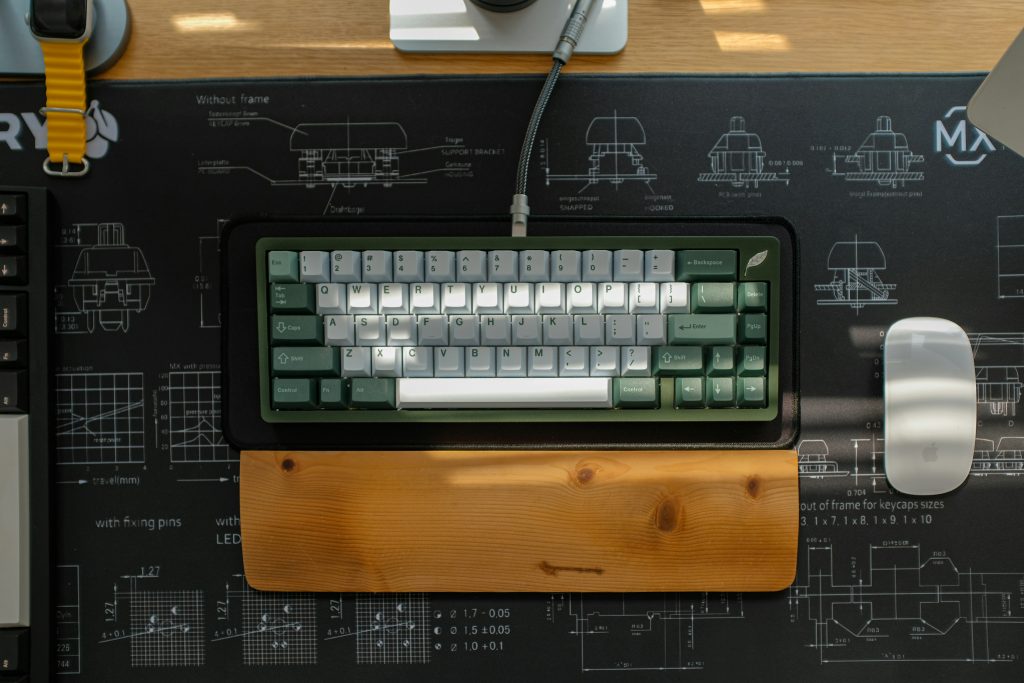Table of Contents
Ergonomic keyboards are designed to reduce strain, improve comfort, and support natural hand movement while typing. But in recent years, the focus has shifted beyond comfort alone—users now seek customizable ergonomic keyboards that adapt to their own typing style, workflow, and personal preference. This guide explores how these keyboards work, their benefits, customization options, and what to consider before buying one.
What Makes a Keyboard Ergonomic?
An ergonomic keyboard is built to promote a neutral wrist position and minimize muscle fatigue. Instead of forcing your hands into a straight line, the layout encourages a more natural posture. These keyboards often feature:
- Split or curved designs that align with shoulder width
- Adjustable tenting angles that lift the center of the keyboard
- Soft, responsive key switches that require less force to press
- Palm rests for additional wrist support
The Rise of Customizable Ergonomic Keyboards

Customizable ergonomic keyboards are gaining popularity because they merge health-focused design with personal adaptability. Instead of a one-size-fits-all model, these keyboards allow users to tailor layout, key functions, lighting, and even typing feel. This flexibility benefits professionals, gamers, writers, and coders who spend long hours at their desks.
Common Types of Customizable Ergonomic Keyboards
- Split Keyboards – These come in two separate halves, letting users position each section independently to match their natural arm angle.
- Adjustable Tenting Keyboards – These raise the middle section of the keyboard, allowing wrists to rest at a more natural tilt.
- Ortholinear Layouts – Keys are aligned in a perfect grid instead of staggered rows, improving finger reach efficiency.
- Compact or 60% Layouts – Smaller versions remove number pads or function rows for a minimalist setup.
- Mechanical Ergonomic Keyboards – Popular among custom builders, they allow swapping of switches, keycaps, and stabilizers.
Customization Options You Can Explore
The beauty of a customizable ergonomic keyboard lies in how you can tweak nearly every element. Common customization areas include:
- Key Switches: Choose between linear, tactile, or clicky switches depending on sound preference and typing feel.
- Key Mapping: Use software to reassign keys or create macros that automate frequent actions.
- Hot-Swappable PCBs: Some keyboards let you replace switches without soldering.
- Keycap Sets: Change material, profile, or color to match your comfort or aesthetic preference.
- Lighting: Adjust RGB patterns or single-color backlighting for better visibility and personalization.
How Customization Improves Ergonomics
Customizing a keyboard doesn’t just make it look or sound better—it enhances how your body interacts with the device. When you position split halves correctly or choose a lighter switch, you reduce strain on fingers, tendons, and shoulders. Proper layout adjustments can also prevent repetitive stress injuries such as carpal tunnel syndrome or tendinitis.
Should You Build or Buy a Custom Ergonomic Keyboard?
You can either buy a ready-made model or build one from scratch.
- Pre-built models like the Logitech Ergo K860 or Kinesis Freestyle Edge are ideal for those who want plug-and-play convenience.
- Custom builds give full control over layout, materials, and components, but they require time, technical knowledge, and a budget for parts.
If you enjoy tinkering or already have experience with mechanical keyboards, a DIY approach might be more rewarding.
How to Choose the Right Customizable Ergonomic Keyboard

When choosing your keyboard, consider these key factors:
- Typing Style – Do you rest your wrists or hover above the keys? Your answer will guide your need for wrist support or a split design.
- Switch Preference – Choose switches that match your pressure comfort and sound level.
- Desk Space – Compact setups benefit from smaller keyboards, while full-sized models suit data-heavy users.
- Software Compatibility – Make sure the customization software works with your operating system.
- Budget and Upgrade Options – Factor in potential upgrades like keycaps or wrist rests.
Examples of Top Customizable Ergonomic Keyboards
- ZSA Moonlander Mark I – Fully split keyboard with hot-swappable switches, tenting legs, and extensive programmability.
- ErgoDox EZ – Known for its modular design and open-source firmware.
- Keychron Q8 – A compact Alice-style layout combining mechanical feel with ergonomic curvature.
- Kinesis Freestyle Pro – Adjustable split halves with optional tenting kits for precise posture alignment.
How Customizable Ergonomic Keyboards Support Productivity
A properly adjusted ergonomic keyboard allows longer, more comfortable work sessions. Reducing muscle fatigue means improved focus and fewer typing errors. For remote workers or gamers, personalized key mapping can streamline shortcuts and commands, saving valuable time.
Maintaining Your Keyboard for Longevity
Keep your keyboard performing well by following simple maintenance tips:
- Regularly clean keycaps and switches with compressed air.
- Avoid spills or exposure to dust.
- Store in a flat, cool, and dry area when not in use.
- For mechanical keyboards, lubricate switches occasionally for smoother performance.
Future Trends in Ergonomic Keyboard Design
The future of customizable ergonomic keyboards is shifting toward AI-driven adaptability—keyboards that adjust automatically to your typing pattern or wrist angle. Expect more wireless designs, modular components, and sustainable materials that combine technology with comfort.
Conclusion
Customizable ergonomic keyboards are more than just tech accessories—they’re tools that improve comfort, efficiency, and long-term health. Whether you buy a pre-built option or design your own, investing in a setup tailored to your needs ensures you type smarter, not harder.
